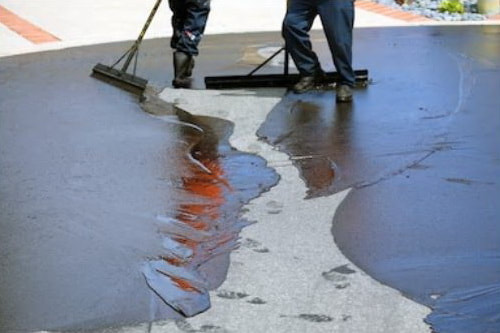Make Best Use Of Safety And Security with Angle Parking Lot: Superior Asphalt Sealing
Cold Mix Asphalt Vs. Hot Mix Asphalt: Which Is Right for You?

Structure Differences
Cold mix asphalt is created by emulsifying the asphalt binder with water and an emulsifying agent prior to mixing it with aggregate. The warm mix asphalt production procedure involves heating up the accumulation and asphalt binder separately before combining them at the asphalt plant.
Furthermore, cool mix asphalt has a tendency to be less thick and extra adaptable than hot mix asphalt. This adaptability makes it better suited for areas with higher degrees of motion, such as driveways or roadways with heavy web traffic. On the other hand, warm mix asphalt is recognized for its high sturdiness and resistance to rutting and fracturing, making it a recommended choice for highways and high-traffic roadways where long life is crucial.
Installation Refine Differences
The process of setting up chilly mix and hot mix asphalt shows remarkable variances in their procedures and demands. Cold mix asphalt, being a more versatile material, can be used directly from the bag or container onto the gap or harmed location. It calls for marginal preparation work, such as cleaning the location and condensing the chilly mix with hand tools. This makes it a hassle-free choice for short-term and quick fixes. In comparison, hot mix asphalt necessitates a much more elaborate setup process. It involves heating the mix to high temperatures before laying it down on a correctly prepared base. The prep work includes compacting the base, using a tack layer, and making use of hefty equipment like pavers and compactors for a smooth and durable surface. As a result of the heating demands, warm mix asphalt setups are usually executed by professionals with specialized devices, ensuring an extra permanent and structurally sound result.
Toughness and Durability Aspects
When considering asphalt options, longevity and long life are essential aspects to assess for long lasting sidewalk performance. Warm mix asphalt (HMA) is understood for its exceptional resilience and longevity.
In terms of long life, HMA usually outperforms CMA as a result of its superior strength and resistance residential properties. HMA pavements have a longer solution life, calling for much less frequent fixings and maintenance, which can translate to cost savings over time. Additionally, HMA sidewalks are a lot more conveniently adjustable to meet particular project demands, better enhancing their resilience.
Expense Considerations
Thinking about the economic ramifications is a vital aspect when examining the selection in between warm mix asphalt (HMA) and chilly mix asphalt (CMA) for sidewalk projects. While the preliminary cost of continue reading this hot mix asphalt is typically greater than that of cold mix asphalt, HMA commonly gives a much more affordable option in the long run due to its remarkable resilience and durability.
In enhancement to product costs, it's vital to think about the costs related to installment and maintenance when contrasting HMA and CMA. HMA generally requires specific devices and competent labor for correct installation, which can impact total task prices. Alternatively, CMA is much easier to deal with and can frequently be used using less complex strategies, possibly reducing installment expenditures. Ultimately, the decision in between HMA and CMA must consider not just the initial expense yet additionally the long-term economic effects to figure out one of the most cost-effective alternative for the particular sidewalk project.
Environmental Impact Comparison
Contrast of the environmental effects in between hot mix asphalt (HMA) and cold mix asphalt (CMA) reveals distinct distinctions in sustainability techniques. HMA production needs heats, bring about raised energy usage and greenhouse gas discharges. The procedure additionally releases unpredictable natural substances (VOCs) and unsafe air pollutants (HAPs) into the environment. In comparison, CMA is produced and applied at reduced temperatures, minimizing power usage and emissions substantially. The reduced manufacturing temperatures of CMA lead to decreased gas intake and reduced degrees of CO2 emissions, making it a much more ecologically friendly choice.
Furthermore, making use of CMA often involves recycling existing asphalt pavement, advertising resource conservation and decreasing the quantity of waste sent to landfills. This reusing aspect additionally boosts the sustainability of CMA contrasted to HMA. Overall, blog here when taking into consideration the environmental influence, CMA becomes an extra ecologically lasting choice due to its lower energy demands, reduced exhausts, and the capacity for recycling existing materials. By choosing CMA over HMA, road building and construction tasks can add favorably to ecological conservation efforts.
Final Thought
In final thought, the choice between cool mix asphalt (CMA) and warm mix asphalt (HMA) depends upon numerous factors such as structure, setup process, toughness, long life, cost, and environmental effect. asphalt repair. While CMA offers a fast and affordable option for small repair services, HMA makes certain exceptional sturdiness and durability for rush hour areas. Take click this link into consideration these elements thoroughly to figure out which type of asphalt is the appropriate choice for your paving needs

Considering the financial effects is a crucial aspect when examining the selection in between hot mix asphalt (HMA) and chilly mix asphalt (CMA) for pavement jobs. While the preliminary cost of warm mix asphalt is usually higher than that of cool mix asphalt, HMA typically offers a more affordable solution in the lengthy run due to its remarkable sturdiness and long life. angle parking.Contrast of the environmental effects between warm mix asphalt (HMA) and chilly mix asphalt (CMA) exposes unique differences in sustainability techniques.In final thought, the selection between cool mix asphalt (CMA) and warm mix asphalt (HMA) depends on different elements such as make-up, installment process, toughness, longevity, cost, and environmental impact